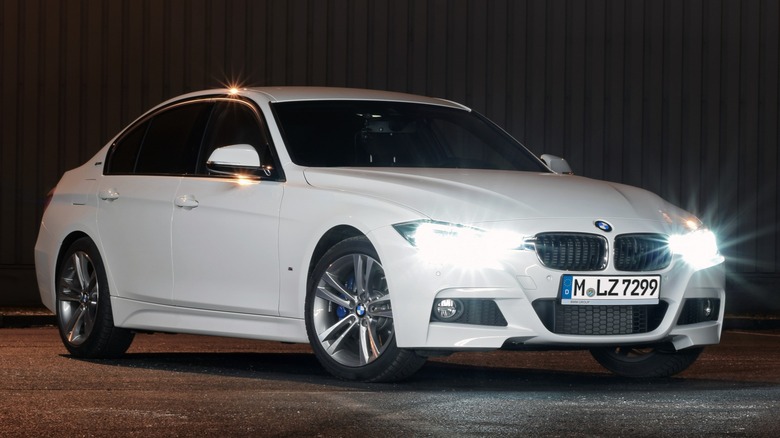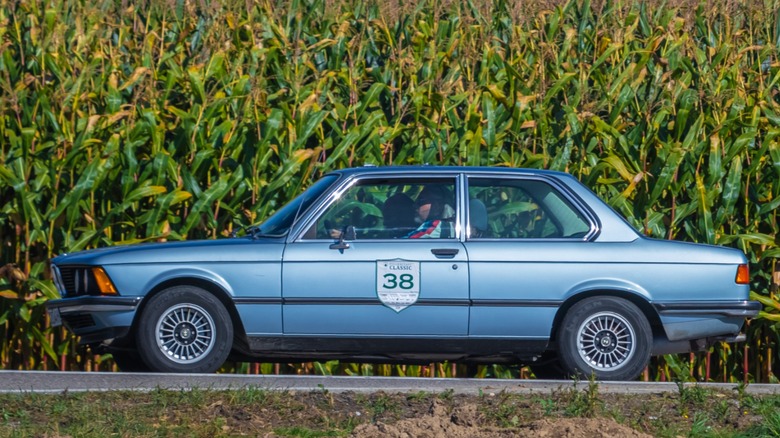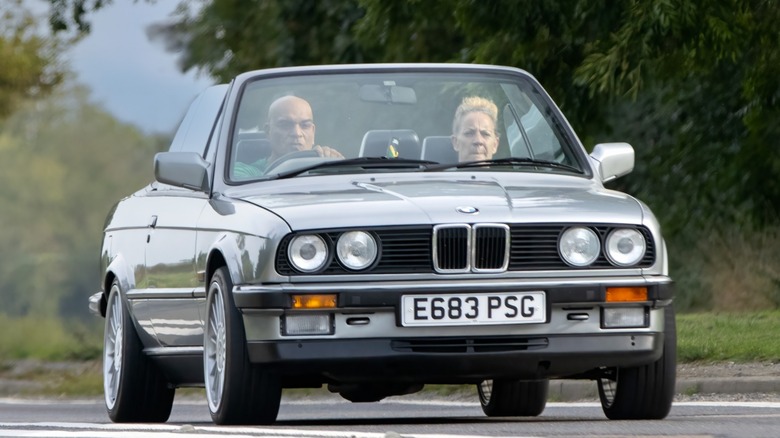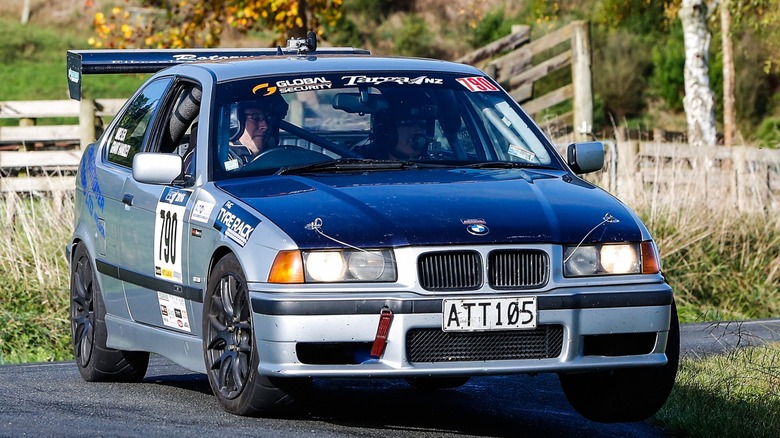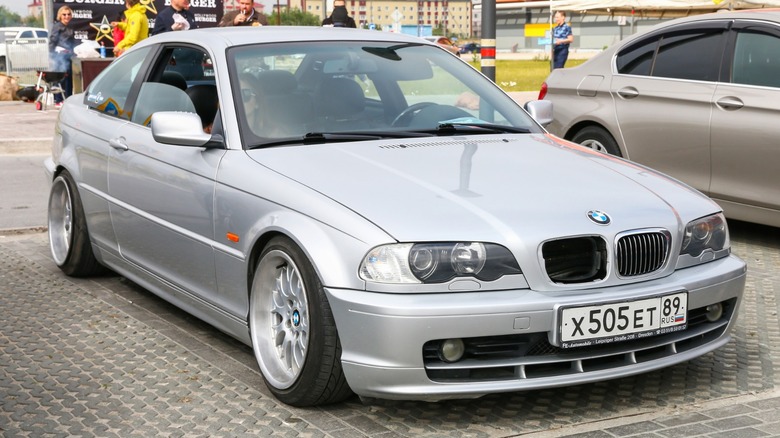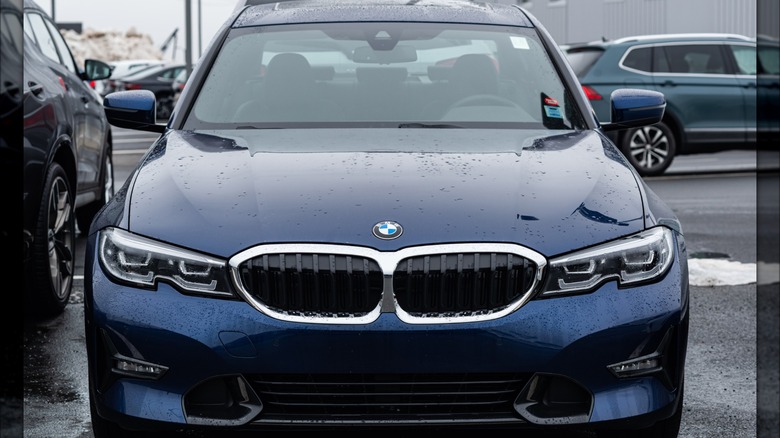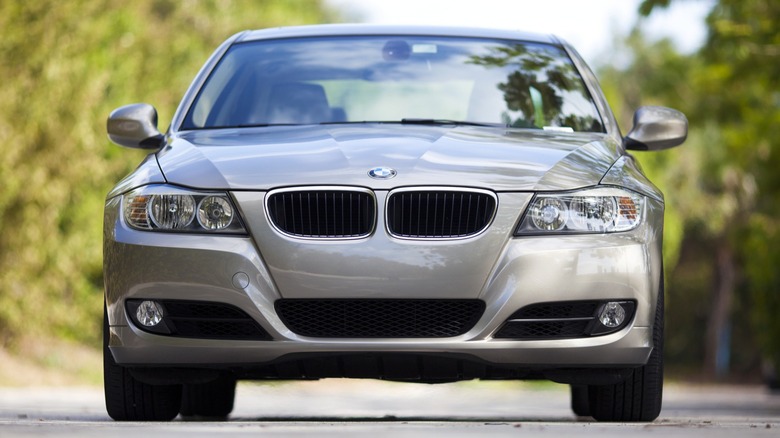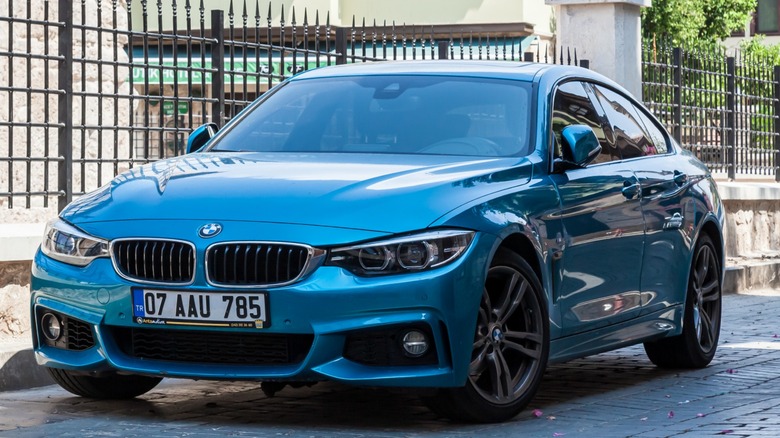Every Generation BMW 3 Series Ranked Slowest To Fastest
German automaker BMW, in 1975, replaced its small and fun 2002 entry-level car with the 3 Series, which is still with us today. Throughout most of that time, the 3 Series has rested at the bottom rung of the BMW ladder, but that in no way means it is a lesser car than the larger 5 Series or 7 Series cars. It is simply the smaller and more affordable "Bimmer."
With an initial retail price of $7,900 in 1975, the BMW 3 Series was always an expensive car — a 1975 Camaro cost less than half that at $3,550. But people who buy a BMW are not doing so to save money; they're doing so to get a car that drives well in a premium package. The BMW 3 Series is sold as a sedan, coupe, convertible, and wagon under various model designations determined by engine size, such as the 318i and its 1.8-liter four-cylinder.
Regardless, every generation of 3 Series has offered drivers a good handling car with sporty acceleration while cradling them in a well-engineered luxury interior. Good performance and handling are a hallmark of BMW design and part of what makes the 3 Series popular. While it would be hard to argue there has ever been a "bad" 3 Series, performance has continually improved across the board. With a look at all of the 3 Series models, excluding the high-performance M3, we can rank them from slowest to fastest.
Looking at models up to last year with the largest engine available from each generation, here are the rankings.
7. BMW 3 Series first gen, 1975-1982
1975 was a tumultuous time for the auto industry. New regulations in the United States altered how cars had to be made while technological advances, such as electronic fuel injection, were becoming more reliable and widespread. Engine options ranged from a tiny 1.5-liter gasoline model fed by a carburetor to the largest 2.3-liter straight-six unit with fuel injection. With the 315 model, drivers only got to enjoy 75 horsepower to get their little BMW going, although the top end of the range delivered a more respectable 143 horsepower, thanks to a mechanical fuel injection system. Even then, few races would be won, but considering a Chevrolet Camaro of the same year gained only two more horsepower with twice the displacement and number of cylinders, it was doing well.
These original 3 Series cars offered few accessories or advanced options, but the interiors were well-appointed and showed that BMW was capable of building premium cars that are attractive and well-built. Furthermore, the interior design of these cars was sporty and driver-focused, with a binnacle full of gauges and what few controls existed all focused toward the driver. While cars today look so much like one another across all brands, back then, the BMW was a starkly different alternative to domestic cars stateside. Though drivers may have looked good in these cars, speed was not the vehicles' most dramatic attribute. With a top speed of 106 mph, they required 11.7 seconds to hit 60 mph and a quarter-mile drag lasted 18.4 seconds. Most economy hatchbacks today are faster than that.
6. BMW 3 Series second gen, 1982-1991
The second time out for the BMW 3 Series, model designation E30, demonstrated an attractive update in styling for BMW as well as more significant updates coming from the engineering department. This generation stuck around for an unusually long ten years while solidifying its place as the car of choice for upwardly mobile career ladder climbers. While the interior of any first-generation 3 Series is nice, looking at interior pictures of its successor shows that BMW put forth significant effort to raise the bar and deliver a car with a well-balanced blend of sportiness and luxury.
Base models of this generation received a slight bump up to a 1.8-liter engine while the range-topper finally received a straight-6 of 2.5-liters with an output of 170 horsepower. With this much power placed in a relatively small car, the performance was tangible, especially considering a contemporary Mustang GT only delivered 225 horsepower. However, lucky buyers in Italy and Portugal who suffered from severe tax penalties on large displacement engines were offered the BMW 320iS model. This one came with an output of 195 horsepower to make up for the fact that the 2.3-liter displacement of the M3 at the time essentially put it out of reach. It would be a rare and valuable car to import today. Nonetheless, the top trim of the regular production cars could hit 60 mph in 8.7 seconds with a top speed of 132. Quarter-mile drags ended in 16.1 seconds when using the 325ix (the x is BMW's designation for cars with all-wheel-drive).
5. BMW 3 Series third gen, 1991-1998
With the 1990s in full swing, BMW had ever-increasing levels of sophistication in technology on tap and it put every bit of that into its revised 3 Series cars, the 1991 to 1998 E36, one of BMW's most underrated vehicles. While the previous generation of 3 Series had updated the styling from its predecessor, this model enjoyed a complete makeover, significantly updating and changing the appearance of the entire range of cars. With more sloping panels and rounded corners, the new car came with a sleek and aerodynamic appearance that looked sharp.
With the updated exterior came a modernized interior that could be ordered with increasing levels of comfort and convenience options. Heated multi-position power seats accompanied by luxury touches like headlight wipers, one-touch window operation, heated washer nozzles, and heated door locks, just to name a few. This is the era that BMW luxury meant you received a plethora of electronic gizmos to make your drive more comfortable and hassle-free. However, it also meant you received exceptional engineering under the hood. This included the first BMW variable valve timing (called VANOS by the manufacturer), and operated the intake valves only, in 1992. While Europeans could get a miserly 1.8-liter engine, everyone else could choose up to a 2.8-liter straight-six. Now with electronic fuel injection, the 2.8 liters provides 193 horsepower to push your luxury sports sedan to its limit. With this range-topping engine, the 3 Series was good for 142 mph and a 0-60 mph time of 8.7 seconds, while a quarter-mile could be cleared in 14.1 seconds.
4. BMW 3 Series fourth gen, 1998-2005
Just before heading into a new millennium, BMW presented its fourth iteration of the popular 3 Series. Though the model line had been undergoing styling and technical changes throughout its existence, the E46 model introduced for the 1998 model year also increased its dimensions, leaving us with a wider, longer, and lower car, all providing for better stability and control. Technologically, this iteration was also extremely advanced, with more electronic accessories than ever. New standard features included Cornering Brake Control (CBC) and Automatic Stability Control with Traction (ASC+T). Furthermore, this model was safer than ever, with multiple airbags installed around all passengers and an electronic brake force distribution standard.
Engine choices continued with the 1.8-liter entry-level option with premium models receiving a 3.0-liter straight-six. 1998 was also the first year for the 3 Series to have double VANOS, meaning it had variable valve timing on both intake and exhaust. This development had an impact on power and efficiency, leading to cars being available with up to 231 horsepower, nearly 40 more than the outgoing models. Fourth-generation cars are also the first to break the 150-mph barrier with a top speed of 157 mph. A sprint to 60 mph in the 330i model took 6.3 seconds, and cleared a quarter-mile in 14.8, a full second over its predecessor.
3. BMW 3 Series seventh gen, 2019-present
Skipping ahead to the present day, we have the current version of BMW's iconic 3 Series. With nearly 50 years of production, the 3 Series automobile has evolved into an impressively advanced machine full of luxury accessories and technological conveniences. Furthermore, even the base model 1.8-liter, which is still offered in some markets, now produces as much power as the largest engine offered when the model debuted in 1975.
Some of the highlights of this modern wunderkind include BMW's Curved Display, which incorporates dual screens for the gauges and infotainment into a single panel that stretches across the dashboard, an available 48-volt mild hybrid drivetrain, variable ambient interior lighting, and an extraordinarily luxurious passenger compartment. The quality of the materials used throughout feels opulent and solidly built. However, with the base price having risen from the original $7,900 to $44,000, it should be luxurious. Powering the new 3 Series, excluding the hybrid setup, is a range of engines up to the 3.3-liter straight-six with 265 horsepower. Paired with the eight-speed automatic transmission and all-wheel-drive, it is good for up to 162 mph and can hit 60 mph in just 5.6 seconds. The quarter-mile run is complete in just 14.1 seconds.
The reason why the newest car is ranked lower than previous models is a change in what models and options BMW has offered over the last few years. Buyers who want the most power and speed are forced to move up into an M3 or choose a different model altogether, meaning earlier range-topping 3 Series models were offered with more power.
2. BMW 3 Series fifth gen, 2005-2015
By 2005, the BMW 3-series had well established itself as a premier luxury car, thanks to 30 years of production and continual improvement. While the exterior had been refreshed and received more slopes and curves than previous models, it still maintained the same familiar overall look of the prior two generations of cars. This consistency is part of what brought the new 3 Series to being named "World Car of the Year," which is voted on by automotive journalists who picked it over 26 other entries that year.
Examples of the advanced engineering available in the fifth generation include components of Advanced Stability Control such as brake drying, brake fade compensation, and comfort stop, all of which go beyond that of typical contemporary passenger cars. Furthermore, this series update received something significant for the first time: turbocharging. With twin turbos on the venerable BMW straight-six, the 3 Series had broken the 300-horsepower mark for the first time. While maintaining a relatively low curb weight at 3,500 pounds, these cars were made properly quick.
Combined with excellent handling already built-in, a 335i from this era could be a fun and fast contender for some friendly racing competition — on the track, of course. The performance of the top model with the 3.5-liter straight-six helped it hit 156 mph, electronically limited while getting to 60 mph in a scant 5.5 seconds, and completing the quarter-mile in 13.7 seconds at 106 mph.
1. BMW 3 Series sixth gen, 2012-2018
For the 2012 redesign, BMW's 3 Series received even more technical upgrades than the last update. Some of them improved handling, such as the Variable Sport Steering combining electric and hydraulic power steering to optimize a perfect ratio under varying conditions. Additionally, since the dawn of the new millennium, American buyers had only options of six-cylinder engines at their dealerships, whereas the 2012 models re-introduced the four-cylinder (albeit, with turbos and a lot more power).
Base model engine choice for this generation moved back down to the 1.6-liter displacement, now appearing in the debut 1975 3 Series, although power output nearly doubled that original car thanks to turbocharging. Moving up the range provides engines of smaller displacement than previous models but with turbos making up the difference. The 3.0-liter straight-six at the top of the range produced a healthy 326 horsepower. With a top trim level 340i with all-wheel-drive, the top speed reaches 169 mph. A quarter-mile only takes 13.2 seconds and the time to 60 mph is just 4.7 seconds. With that kind of acceleration to pin you to your seat, this is the fastest production BMW 3 Series ever made without an M badge.
